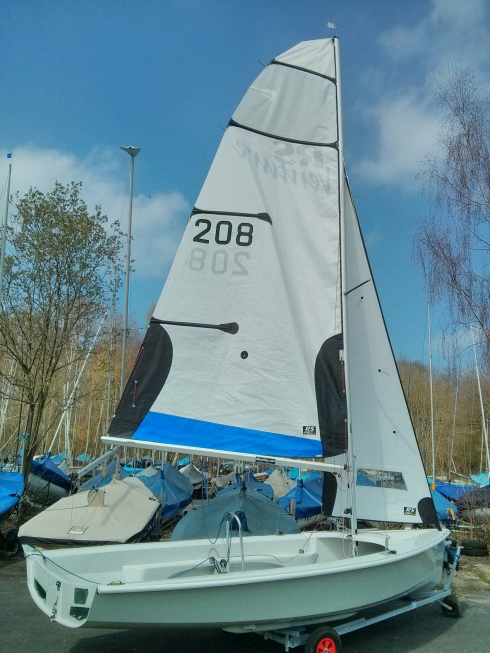RS Venture: Mast
This section lists the various mast fittings from top to bottom. The RS Venture mast is dual purpose and able to support either a gennaker or spinnaker system. The mast is heavy and requires two persons to put the mast in position.
Mast TopThe RS Venture mast is by Seldene. It has fittings to serve both Gennaker and Spinnaker sail systems. At the top front end it has a steel block that is intended as a top pulley for a Spinnaker sail, also a mast clip to hold a wind indicator. At the top rear is the pulley block for the Main Halyard. The main halyard is fed down the centre of the mast and emerges at the foot of the mast on the starboard side.
Gennaker top blockThe gennaker hoist block is rivetted into the mast just above the forestay fastening. The launch line (black in the photo) extends down the centre of the mast and emerges from the starboard side of the mast.
ForestayMoving down the mast the next fitting is the fixed ring fastening for the forestay wire. This terminates in a Wichard spring shackle that fastens to the ring in the centre of the fore deck when the boat is ashore.
Jib WireBelow the forestay wire is the steel Jib wire pulley block. The Jib wire has a spinner coupling attached to the upper end and a wire loop attached to a soft rope tail with a large rope stopper. The Jib wire travels down the centre of the mast and emerges just above deck level at the rear of the mast.
Upper Gnav bracketThe top of the Gnav strut is fastened to the mast via this bracket. The main link is via a 6mm stainless steel drop-nose pin or bolt. Drop-nose pins are expensive and easily lost so when towing either remove these and keep them safe or tape the pins to the bracket. Note if pins are lost then stainless steel 6mm bolts with 6mm locknuts will act as excellent replacements. The only downside is that the bolts are more fiddly to remove and replace.
Note that the pins each have a 6mm stainless washer. The washer should be positioned at the top of the pin in the upper gnav bracket to absorb the thrust.
Spinnaker RingFurther down the mast at the front is a sizeable ring used to mount the spinnaker pole. The ring may also be used with a modified boat hook to act as a goosewing strut.
Boom Gooseneck bracketThis provides the main fastening between the boom and the mast. The main fastening is via a 6mm stainless steel drop-nose pin or bolt. Note the pin washer should be positioned at the bottom of the pin in this lower gnav bracket. The gooseneck also provides a path for the downhaul line.
Kicker control cleatThe Kicker control cleat is sited just below the gooseneck bracket and is placed to be operated by the crew.
Downhaul CleatThis is sited on the port side of the mast.
Mast Gate and steel protection collarNeither the mast gate nor the protection collar have a permanent role. These components usually function as the mast is being inserted or removed from the boat but in service the mast is fully supported by the shrouds and Jib wire or forestay wire.
Gennaker lower pulley blockThe gennaker line emerges from the starboard side of the mast and runs forward to a fixed block sited in the bow.
Main Halyard pulley blockThe main halyard emerges from the starboard side of the mast on to a small fixed pulley block. The arrangement enables the halyard to be hauled up by a crew member standing in the starboard side of the boat and pulling upwards. This provides a greater purchase by allowing a crew member to use leg muscles to assist hoisting the main sail.
Jib Tensioning PulleyThis small pulley is fastened to the lower rear section of the mast and enables the jib wire to be tensioned using an upward pull via a rope pulley system giving a 3:1 advantage..
Spinnaker lower blockThis block is sited at the front bottom of the mast from which the Spinnaker sheet will emerge. This has no useful function on the standard RS Venture
Mast Step blockThis is a cast aluminium block fastened into the bottom end of the mast. The casting is shaped to allow a limited fore and aft vertical movement of the mast rake and also to fit between the stainless steel locating bolts on the mast step bracket. When stepping the mast take care to check that the foot of the mast is properly located between the two locating bolts in the mast step bracket.
